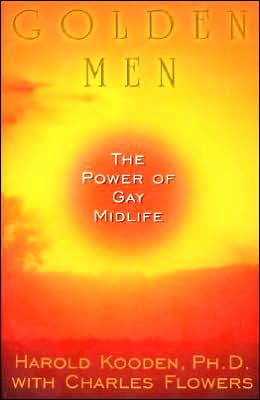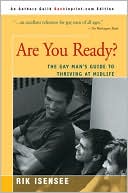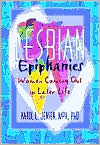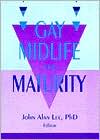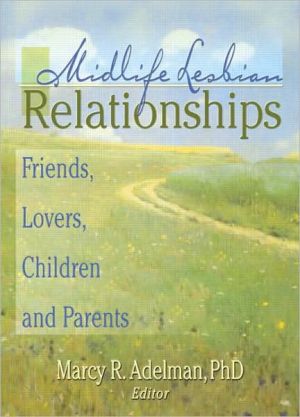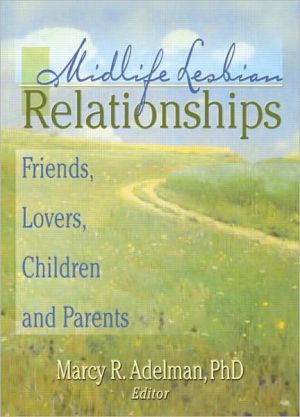Golden Men: The Power of Gay Midlife
Perhaps nowhere is the American obsession with beauty and glorification of youth more prevalent than in gay male culture. Aging, however, is an inescapable fact of life. Negativity and prejudices about this inevitable process can often result in a midlife misspent in self-loathing and despair.\ Noted gay psychotherapist Dr. Harold Kooden draws on new research and his vast professional experience to separate facts from fears, as he examines aging and its impact on key areas of gay life: body...
Search in google:
Perhaps nowhere is the American obsession with beauty and glorification of youth more prevalent than in gay male culture. Aging, however, is an inescapable fact of life. Negativity and prejudices about this inevitable process can often result in a midlife misspent in self-loathing and despair.Noted gay psychotherapist Dr. Harold Kooden draws on new research and his vast professional experience to separate facts from fears, as he examines aging and its impact on key areas of gay life: body image and sexuality; physical and spiritual health; work and play; friendships and relationships.For the first openly gay generation in the U.S. entering a new life stage, this remarkable book offers help, strength, support, and direction-revealing how the skills mastered in a hard-won struggle for survival, recognition, and respect can play an important part in every gay man's empowerment and acceptance of his self in midlife. Venus For the first openly gay generation in the U.S. entering a new life stage, this remarkable book offers help, strength, support, and direction -- revealing how the skills mastered in a hard-won struggle for survival, recognition, and respect can play an important part in every gay man's empowerment and acceptance of himself in midlife.
Chapter One\ \ Body Image and Sexuality\ \ In May 1998, SAGE (Senior Action in a Gay Environment) hosted the first national conference on aging in the lesbian and gay community. Approximately four hundred people gathered at Fordham University in New York City to hear academics, social workers, therapists, and lesbian and gay members of the community discuss ageism and aging within a lesbian and gay context. The keynote speakers were Dr. Robert Butler, who first coined the word ageism, and Del Martin and Phyllis Lyon, the pioneering founders of the first national lesbian organization, the Daughters of Bilitis, who are now actively involved in OLOC (Old Lesbians Organizing for Change).\ Perhaps the most telling moment of the entire conference came during an open discussion following the Saturday morning plenary on "Self Image and Aging." The lesbians on the panel, as well as female members of the audience, were like old-time revivalists preaching the gospel of activism. They detailed the efforts of groups like OLOC to fight ageism in general and in the gay community in particular with consciousness- raising efforts, campaigns to protect Medicare and Medicaid, boycotts, petitioning, and participation in national efforts like the White House Conference on Aging. These women were inspiring and courageous, and their energy galvanized many members of the audience, who whooped and hollered their support.\ In contrast, the gay men in the audience seemed more wary, confused, and fearful on the subject. One of the male panelists was a pioneer in the field of gay civil rights, but around the issue of aging, he seemed like a neophyte, sayinghe had never experienced ageism. One observer suggested that since he was relatively wellknown within the gay community, the power of his celebrity had buffered him from ageism. Many men in the audience stepped up to the microphone to admit feelings of powerlessness, despair, and absolute dread over getting older. A common feeling was "Younger men don't look at me anymore, and if they do, they look away." While the lesbians were active, involved, and motivated, the gay men present generally appeared more passive, shut down, and hopeless about aging.\ The differences between lesbians and gay men are many, but the gender divide has never been more visceral to me than in that discussion of ageism. Part of the disparity between how lesbians and gay men are reacting to their aging is clearly connected to the differences between how the two communities relate to their bodies and the value that each assigns to them.\ In general, the majority of negatives around aging involve the body, while many of the positives about aging have nothing to do with it (such as the freedom to do as one pleases or to speak one's mind; financial stability; a strong emotional support system; a sense of finally having arrived in the world). Based on the comments made at the SAGE conference, it seems clear that these lesbians are aging better than the gay men because they assign less value to their bodies. It's not that their bodies are unimportant, it's that these lesbians tend to recognize and value a woman in her entirety—not just her body but also her intellect, her personality, the whole package. In contrast, gay men tend to commodify their bodies like so many packages of meat.\ Gay men are deeply invested in their bodies, and many feel that their body is their best asset—not only for sex, but for feelings of attractiveness, power, and success. The more other men respond to their bodies, the more a gay man will feel good about himself (a phenomenon many nongay women experience). For many gay men, the body is a form of currency in the free market of desire, shaped by the supply and demand for sex and romance (preferably one is in demand and willing to supply). Or, as Andrew Holleran observes in his essay, "Survivors": "We're told it's what's inside, not outside, that counts, but on the street the outside is the medium of exchange," while the city operates "as a vast exercise in retail."\ But by assigning so much value to the one thing that is most negatively affected by aging, many gay men are setting themselves up for a horrible experience at midlife, when their bodies begin to change. Extending the economic metaphor, aging then becomes a form of inflation, making our bodies lose value. Even when nothing else changes in his life, when a gay man reaches midlife and his body begins to go through its natural changes, his entire worldview can become jeopardized.\ The task in this chapter and the next is to understand your relation to your body at midlife. Through focusing on body image and sexuality, many of us can begin to understand how our negative assumptions around aging and our perceptions about the body can affect the reality of our midlife. In the next chapter, I address both our physical and mental health in a new concept of well-being based on the facts of aging, not the fears.\ OUR BODIES, OUR SELF-WORTH\ For many gay men, the body is a prison of expectations. We are expected to look a certain way, dress a certain way, behave a certain way-all because we're gay men. On one level, this pressure to conform is part of a group dynamic. Every social group has requirements to belong, a "price of membership," and in many parts of the gay community, the cultural standard is set with an idealized body. So many gay men took in the mirror, only to shudder and start listing what they should be doing but aren't. "I should eat better, cut out the ice cream at night." "I should go to the Gap and buy a hip shirt to make me look younger." "I should get more sleep." "I should lose this belly." "I should cut my hair real short." "I should get a tattoo."\ The problem is not with their bodies, but with their "shoulds"those nagging self-criticisms which only compound low self-esteem. Whether or not they exercise regularly or eat right, many gay men experience a constant feeling that "I don't look the way I should." Yet those unrealistic expectations are the real enemy, not the body. A quick look at the gay media reveals how such expectations get reinforced, with pages and pages of images of the gay cultural ideal...
\ VenusFor the first openly gay generation in the U.S. entering a new life stage, this remarkable book offers help, strength, support, and direction -- revealing how the skills mastered in a hard-won struggle for survival, recognition, and respect can play an important part in every gay man's empowerment and acceptance of himself in midlife.\ \ \ \ \ GoldThere is no doubt in my mind that Harold Kooden, a clinical psychologist, is eminently qualified to write a book detailing a plan for successful aging for gay men: He's a founding member of both the Association of Gay Psychologists and the National Gay and Lesbian Health Foundation. Now he has set his sights on a new task: helping gay men achieve a well-adjusted transition into their later years.\ —The Advocate\ \
